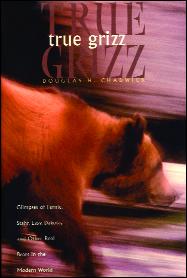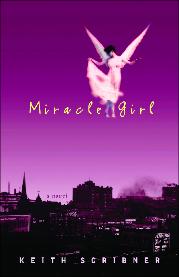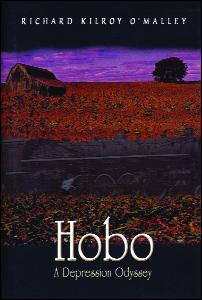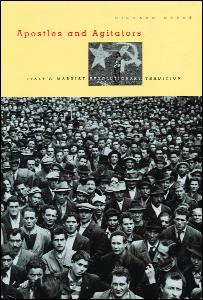Books
by Paddy MacDonald
 True Grizz
True Grizz
by Douglas H. Chadwick ’74
San Francisco: University of California Press, 2003, 176 pp., $24.95
Ursus Arctos Horribilis is a species defined less by science than by human emotion, Douglas Chadwick explains in his seventh book on natural history. But grizzlies are far more complex than the indiscriminate carnivores of legend. In fact, Chadwick, after a decades-long study, sees a remarkable correspondence between a grizzly’s nature and our own.
“Bears are about as different from one another in terms of habits and temperament as one human is from the next,” Chadwick says, portraying grizzlies as intelligent, mercurial creatures that have little choice but to share the landscape with us. Most of the ursine personality profiles in Chadwick’s book were gleaned from bears as they engaged in their ongoing quest for food: Daryl, a “C student in need of improvement;” her brother Blade, who fritters away his afternoons digging for the starchy roots and kinnikinnick near a Flathead County roadside; Stahr, who once scored a 300-pound sack of dog food; Louie, who burglarized an unoccupied cabin to feast on the strung-up deer carcass hanging inside; Fernie and her cubs, Nip and Tuck; and B.C., a “North Fork troublemaker.”
Chadwick joins a crew of wildlife managers as they attempt to re-educate grizzlies that habitually venture into human settlement. According to Chadwick, averse conditioning—using frightening or painful stimuli, such as rubber bullets and “cracker” shells—is far superior to relocating, since the grizzly will either return to its original scavenging ground or find a new area, equally close to humans.
The book’s core lies in a dramatic passage that chronicles Chadwick’s encounter with a grizzly in Glacier National Park. Watching and following “Real Bear,” the author paints a dazzling portrait of the wilderness, its inhabitants, and his own awestruck response: “You can’t escape . . . the feeling of having cast off earthly things to stand unadorned before powers far greater than your own.” But when Real Bear switches roles from the trackee to the tracker, Chadwick quickly discovers that “you face questions about the stuff you’re made of . . . and that what you want out of life above anything else . . . is to remain alive.” In spite of this heart-clutching encounter—perhaps, because of it—True Grizz reads like a love story.
 Every Good Boy Does Fine
Every Good Boy Does Fine
by Tim Laskowski, M.A. ’88, M.F.A. ’88
Dallas: Southern Methodist University Press, 2003, 176 pp., $23.95
Robert Nyquist, the narrator of Tim Laskowski’s debut novel, lives in a group home, where he struggles to find an anchoring reality, consistent patterns, a way to behave that’s acceptable to him and to his caregivers. “Normal” is no longer possible for Robert, who sustained permanent brain damage in a rock-climbing accident thirteen years before the story begins. Instead, he and the other residents are encouraged to learn appropriateness: “Being appropriate is what we strive for, what we live for, waiting for cues from an able-body to know whether we should laugh or goddamn cry or sit there and do nothing.”
Adapting to his environment, Robert negotiates a relationship with Lorna, a fellow resident, and endures the occasional, pained visits from his parents and son. He plays the piano and soaks in his bath tub, enjoying his only “private time.” Then, Robert is offered a chance to improve his situation: “Transitions,” a program that could teach him more self-reliance and lead, possibly, to his own apartment.
But Robert has a secret. He’s uncomfortable with the new options available to him. Choices have consequences. In Robert’s experience, those who allow themselves to be seduced by life’s possibilities are sometimes made to pay—like Robert himself, who left his Hi-Line roots for college, fell in love with a new landscape, and dared to dream different dreams. He harbors the conviction that falling off a cliff was his punishment for wanting more, for not being a “good boy.”
Robert’s most reliable escape from a sometimes cruel and difficult life comes through acts of imagination, where he conjures up memories of his pre-injury self or floats through a powerful, self-preserving fantasy, such as that of his own miraculous recovery.
The candid glimpse into a disabled person’s consciousness is at once the most poignant, astonishing, and nerve-thrumming aspect of Laskowski’s novel. We shrink from Robert’s pain as we’re again reminded that life isn’t fair. But Robert is able, finally, to find grace in acceptance, even as he continues his struggle to establish common bonds and share intimate moments with those he holds dear.
 Miracle Girl
Miracle Girl
By Keith Scribner, M.F.A. ’91
New York: Riverhead Books, 2003, 257 pp., $23.95
If recognition begets mirth, Catholics, in particular, will appreciate the humor in this rollicking, iconoclastic novel, Scribner’s second. A software employee named Sue Phong, through no design of her own, begins appearing in people’s dreams and in the process, disrupts routine, quietude, and all common sense in Hudson City, a hard-up town that missed the economic miracle of the nineties. Suddenly, bum legs are restored, kidney stones dissolve, and pilgrims clog the streets, all hoping for an audience with the “miracle girl.”
The miracle girl is a thorn in the side of Bishop Frank O’Connor, a “practical man in a spiritual world.” But for Buddy Jensen, a morally ambiguous real estate agent, the miracle girl is a commodity to be hauled out at parades, groundbreakings, and ribbon-cuttings.
John Fitzgerald Kennedy Quinn inventories and sells space for Bishop O’Connor’s diocese. Periodically updating the color-coded maps that line his office wall, Quinn strikes an occasional underhanded deal with Venable Realty, while trying to stay out of the bishop’s gun sight. At home, where he lives with his yoga-practicing girlfriend Rita, Quinn sands wood on his back stoop or labors over a jigsaw puzzle. To him, the miracle girl is “mostly about traffic,” since her advent has brought on a massive parking dilemma.
But Quinn soon becomes entangled in the conflicting agendas of Bishop O’Connor, a man who “takes secret pride in cracking walnuts with his bare hands,” and Buddy, who likens the potential economic windfall to “opening up China,” and who’s not above using a little blackmail to involve Quinn in his schemes.
The novel is peopled with off-beat, marginally flawed characters, among them the wise-cracking Sister Rosemary, “who looks like she belongs on the cover of Redbook for Nuns,” and Father Timothy Floquet, the spindly parish priest whose church sermons are now heard by throngs, who’s caught up in the carnie-like atmosphere, and who will, if the bishop has his way, “have a few years making jam in a monastery to think this over.”
The novel’s theme is faith: in the miracle girl; in memory; in effort; and most importantly, Quinn’s faith in himself—that he’ll find the correct puzzle piece, make it fit, and do the next right thing.
Books in Brief
 Hobo: A Depression Odyssey
Hobo: A Depression Odyssey
By Richard Kilroy O’Malley ’35
Sun City, Arizona: Jeanne B. O’Malley, 2002, 272 pp., $14.95
After losing his job in Butte’s copper mine during the Depression, the narrator of this largely autobiographical novel by the late author of Mile High Mile Deep embarks on a train-hopping search for work. Armed with a knapsack, a blanket, and twenty dollars stuffed into a Bull Durham sack, Slim Maloney encounters, over the course of a 10,000-mile journey, a Shakespeare-quoting bootlegger, a hangman, a Chinese ranch cook, and “Terrible Turk,” a carnival strongman. For eating money, Slim digs potatoes, plays piano, pushes broom, and washes cars. Slim, not quite nineteen when he returns home to his family, is an authentic voice for those who struggled to find their way through one of the most desperate times in history.
Hope and Dread in Montana Literature
By Ken Egan Jr. ’78
Reno, Nevada: University of Nevada Press, 2003, 183 pp., $34.95
Ken Egan Jr. examines Montana’s rich literary tradition in this intellectually provocative survey, in which he calls Montana’s literature dialectic “to the core, reflecting competing responses to common concerns.” Juxtaposing tales of violence and tragedy with those of endurance and triumph, Egan demonstrates the state’s conflicted history and offers the possibility of thoughtful solutions to the West’s daunting social and environmental dilemmas through the writers’ insights. The works of such literary luminaries as A.B. Guthrie, Ivan Doig, Jim Welch, Richard Hugo, Mary Clearman Blew, Bill Kittredge, and Richard Ford are discussed, as are the narratives of early explorers, ranchers, American Indians, and women settlers.
 Apostles and Agitators: Italy’s Marxist Revolutionary Tradition
Apostles and Agitators: Italy’s Marxist Revolutionary Tradition
By Richard Drake
Cambridge, Massachusetts: Harvard University Press, 2003, 283 pp., $45
In his timely study of the ways in which an ideology of terror becomes rooted in society, Richard Drake, UM professor of history, explains the character of the revolutionary tradition to which so many Italians professed allegiance, examining its origins and internal tensions, the men who shaped it, and its legacy. The book ends with a disturbing coda in which Drake recounts the recent murders of the economists Massimo D’Antona and Marco Biagi by the new Red Brigades, whose Internet justification for the killings is steeped in Marxist revolutionary tradition.
Shroud Across the Valley
By Kalli Deschamps ’69
Missoula: Kalli Deschamps, 2003, 247 pp., $21.99
Conflict between environmental extremists and cattle ranchers provides a backdrop for this murder mystery, set in a Rocky Mountain valley in the 1990s. The book opens with the disappearance of Kyle Johnsrud, a prominent rancher. After weeks of intensive searching, his body is found by four friends. Clues to the murder accumulate, and just as a prime suspect is emerging, someone shoots him, sending the plot into a new direction. The novel ends with a type of rangeland justice.